Colorado is home to spectacular wildlife, from tiny pikas to powerful cougars. The remote location and dizzying height of its mountains, including those in the Rocky Mountains, keep many humans away, meaning animal life flourishes. Let’s take a look at nine animals roaming Colorado’s tallest mountain.
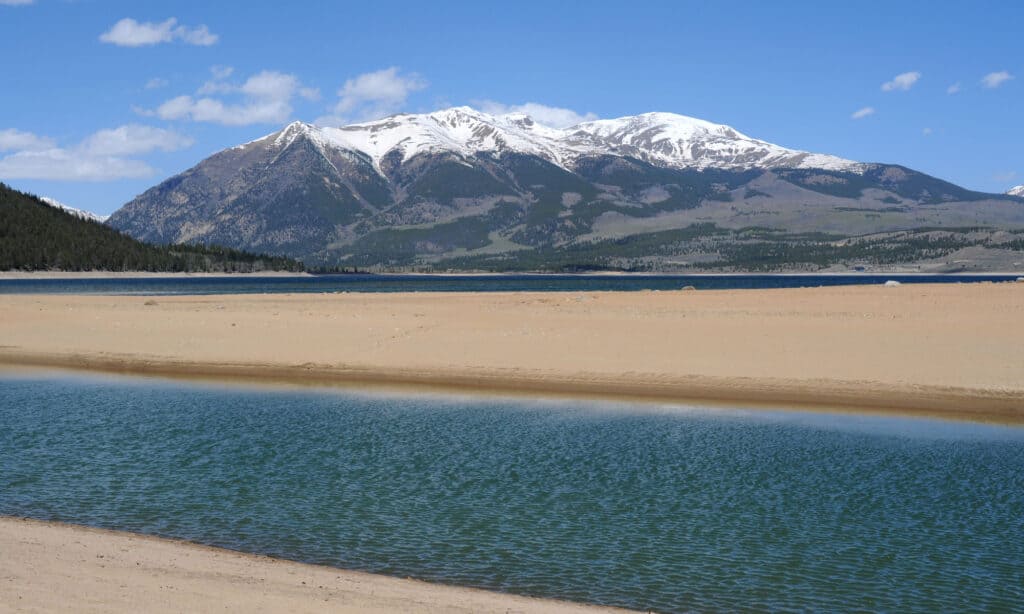
Mount Elbert is the highest peak in Colorado, standing 14,440 feet tall.
©iStock.com/SeanXu
What Is Colorado’s Tallest Mountain?
The tallest mountain in Colorado is Mount Elbert in the Rocky Mountains. It’s an epic 14,440 feet tall, and that makes it not just Colorado’s tallest mountain but the tallest of the Rockies. It’s the second-highest peak in the U.S., snow-capped and remote. This mountain is home to a variety of incredible animals and plants. Although human settlement in the Rockies caused native apex predator decline, many have recently returned due to conservation projects. Let’s jump in!
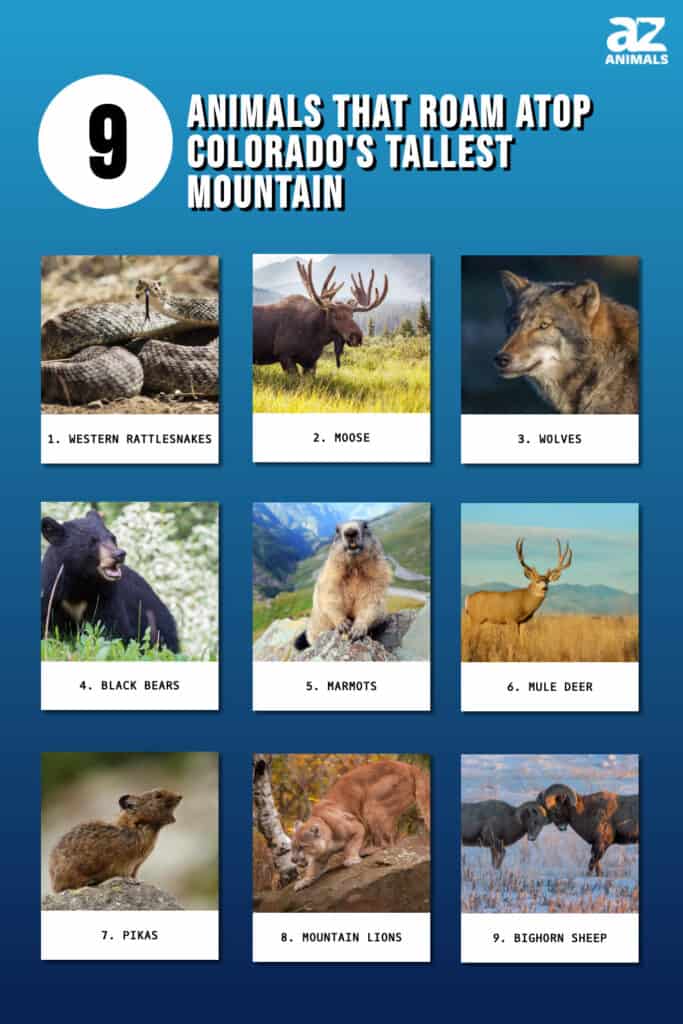
1. Western Rattlesnakes
Just one venomous snake resides on Mount Elbert, and that’s the western rattlesnake, also known as the prairie rattlesnake. This 4-foot long pit viper lives below 8,000 feet, so you might not encounter one on the snow-topped peak, but potentially could on the hike up there.
Western rattlesnakes have a mixture of brown, red, yellow, and deep rust red with off-white shades and dark brown diamond-shaped patterns running the length of their back. A triangular head holds fangs that inject venom into its chief rodent and bird prey.
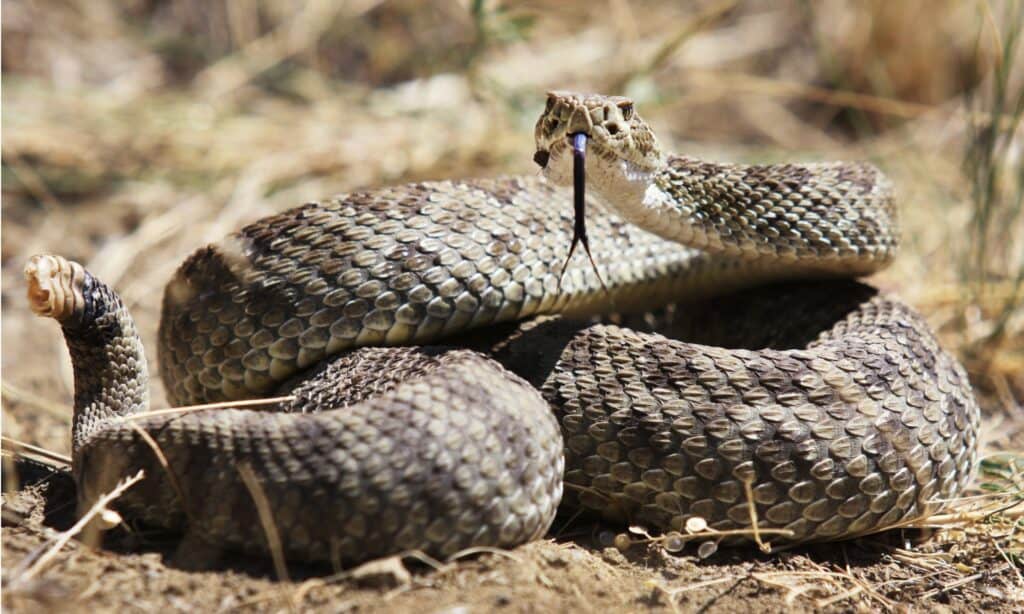
Western rattlesnakes live in the lower regions of Mount Elbert.
©iStock.com/HRossD
2. Moose
Moose live near the higher peaks of Mount Elbert. They are the heaviest deer species and the largest animal in the Rocky Mountains, with adult males standing between 5 and 7 feet tall and weighing up to 1,600 pounds. They are solitary creatures and prefer to live alone, only coming together to find mates. Moose are unpredictable towards humans or domestic dogs, and their huge size means they can handle a devastating blow from their hooves, antlers, or sheer body weight.
Herbivorous moose forage grasses, flowers, moss, bark, and buds, clearing snow and frost from patches of vegetation with their powerful hooves. Adults have few predators, but wolves, bears, and large cats prey on calves.
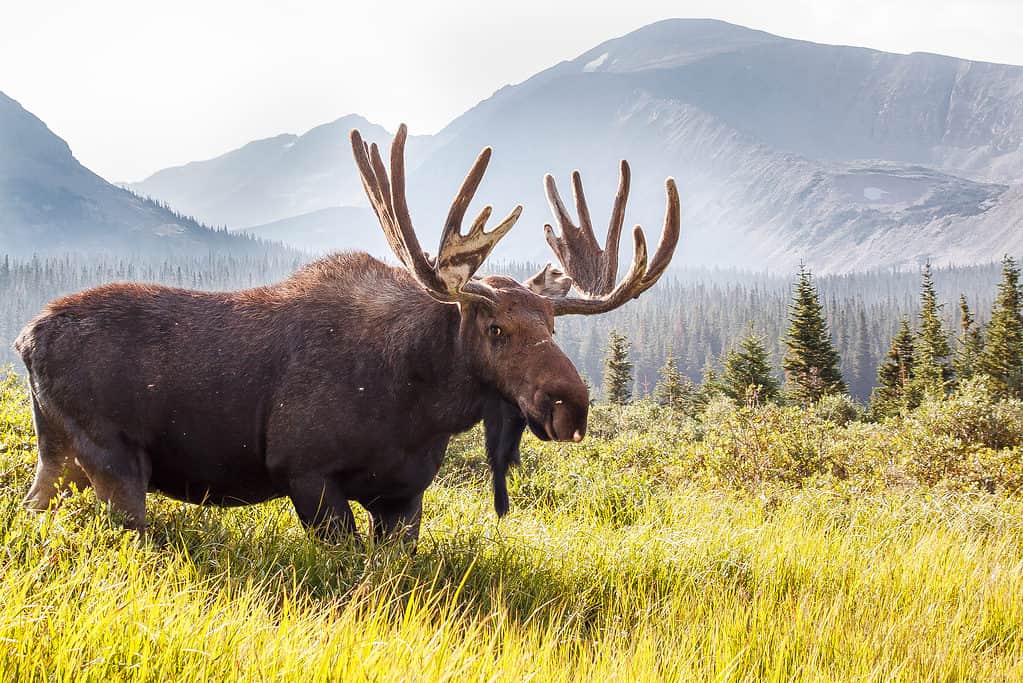
Moose are the largest animals living on Mount Elbert’s slopes.
©Michael Liggett/Shutterstock.com
3. Wolves
Wolf packs live in the Rocky Mountains, but there are nowhere near as many as there were before humans settled in the area. Wolves were once common in the region but were hunted to extinction by settlers and government incentives. Experts believe Colorado’s last wolf was shot in 1940. Reintroduction to preserve the ecological balance proved successful in the 1990s. It’s estimated 1,500 wolves now inhabit the Rockies, where they prey on moose calves, deer, and rodents.
Wolves tend to avoid human contact, but they pose a danger, so they should always be avoided. Rocky Mountain wolves near Mount Elbert range from black, silver, and bluish-gray in color. Males reach 150 pounds, and the pack can reach 46 mph when hunting.

Rocky Mountain gray wolves were hunted to extinction, but conservation efforts mean several packs now thrive there.
©Szczepan Klejbuk/Shutterstock.com
4. Black Bears
Black bears are the Rocky Mountains’ most common bear species. Grizzlies live there too, but black bears outnumber them.
These incredible predators tend to live in forested areas with chokeberries and serviceberries, but they roam vast distances in search of food and mates. They’re one of the few species making use of the highest part of Mount Elbert, the alpine zone.
Despite the name, a black bear’s thick fur ranges in color from black to brown, tan, red, blonde, and light brown. Adult males weigh up to 594 pounds and reach 6.5 feet standing upright. The oldest black bears make it to 40 years old! Although they’re hefty-sized animals, black bears can run at 30 mph and easily outpace an average human or pet dog.
Needless to say, Mount Elbert hikers should be aware of black bears and the dangers they pose. These predators will usually avoid humans, but attacks have occurred.
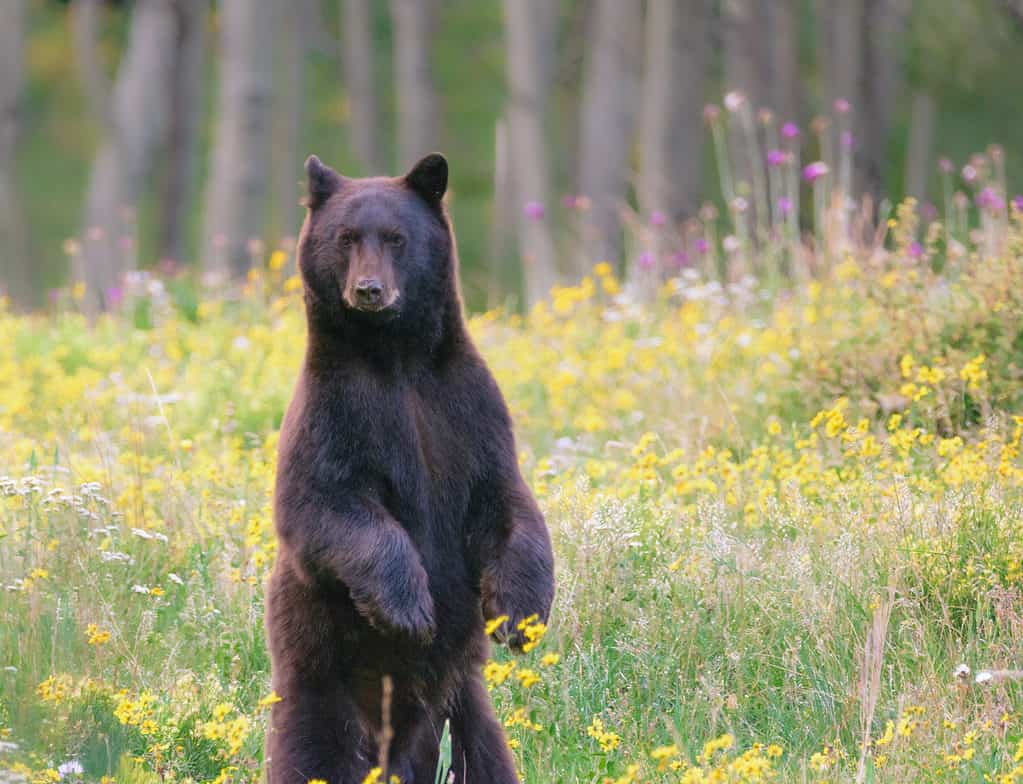
Black bears weigh up to 594 pounds and run at speeds of 30 mph.
©Constance Mahoney/Shutterstock.com
5. Marmots
Marmots, also called groundhogs, live in rocky subalpine Rocky Mountain habitats. These 18.5 to 27.5-inch-long rodents have brown fur with yellow bellies and subsist on nuts, seeds, grains, and grasses found on Mount Elbert’s slopes.
They’re social animals that live in colonies, excavating burrows that protect them from sub-degree temperatures in the winter months. When predators approach, marmots give out a shrieking whistle to warn their colony of danger, earning them the nickname “whistle pig.” Despite their whistle warning, a marmot’s eyesight is poor, and they like to spend time sunbathing on rocks. Unfortunately, this habit makes them prey to wolves, big cats, and birds of prey.
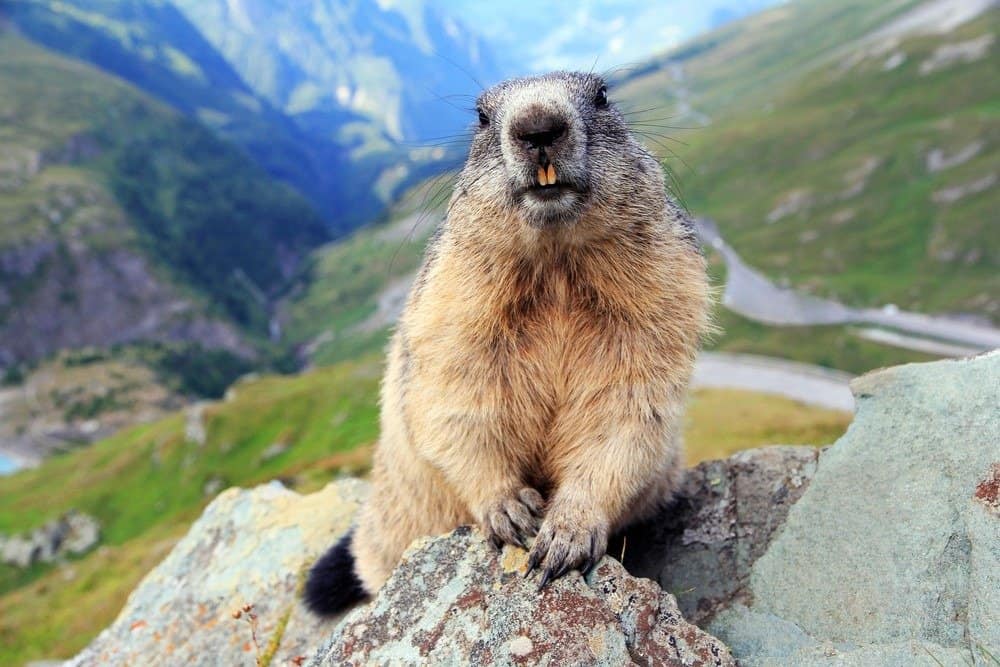
Colonies of marmots live on Mount Elbert’s rocky slopes. They whistle to warn the colony of dangers.
©Astrid Gast/Shutterstock.com
6. Mule Deer
Mule deer are among the most common animals found on the Rocky Mountains’ tallest peak. They look very similar to white-tailed deer, but they have black tails, forking antlers, and large mule-type ears that earn them the name mule deer.
Males can reach up to 460 pounds and 6.9 feet from nose to tail tip. They spend nearly all their time grazing on vegetation and chewing the cud (that’s chewing vegetation regurgitated from a grazing session).
Mule deer traverse most of Mount Elbert, searching for grasses, flowers, buds, and leaves. They tend to stick near forested areas for cover because youngsters are preyed upon by black bears, wolves, and mountain lions. Mount Elbert’s Black Cloud trail is among the best places to spot a mule deer.

One of the most common animals in the Rocky Mountain range is mule deer.
©Kirk Geisler/Shutterstock.com
7. Pikas
Fluffy brown or black “blink-and-you’ll-miss-them” pikas live in the higher regions of Mount Elbert, where they live out harsh winter months on vegetation, nuts, and berries they’ve collected and stored in burrows. Winter temperatures may seem harsh to us, but pikas thrive in the cold. In fact, if the mercury hits 77 degrees Fahrenheit, a pika won’t survive more than a few hours due to its fully insulated fur coat.
Cute and cuddly pikas have adorable round ears, chubby bodies, and no tail. They are around 8 inches long and resemble rodents but are actually related to rabbits. Like marmots, they live in colonies, each with its own den and whistle to flag up predators, including weasels and eagles.
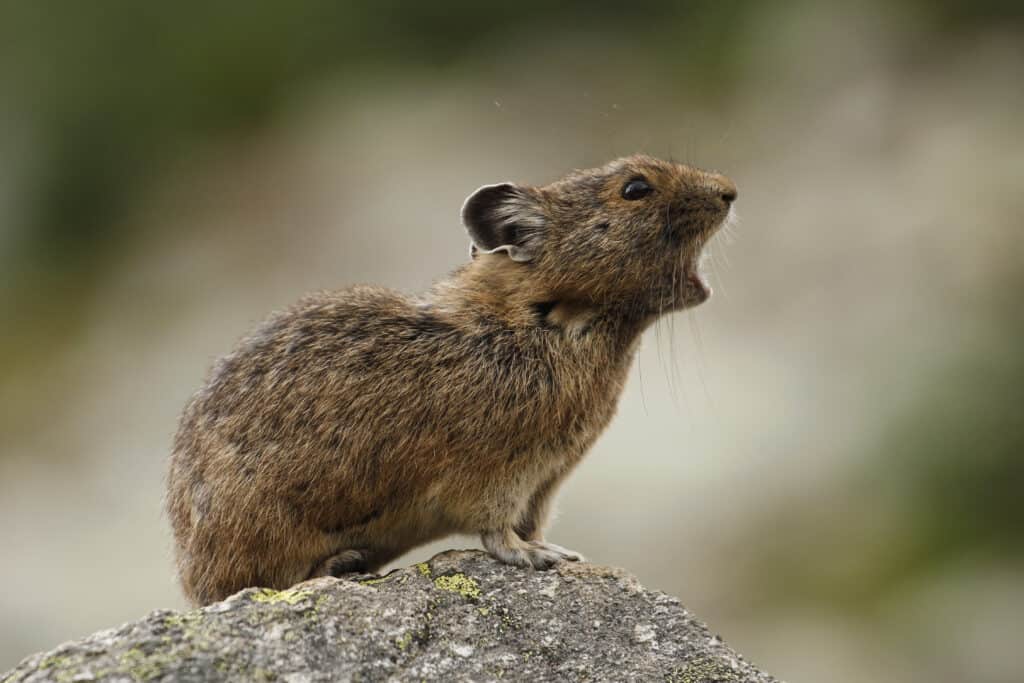
Thick-coated pikas thrive in Mount Elbert’s cold alpine regions.
©iStock.com/Shayne Kaye
8. Mountain Lions
Mountain lions, also called cougars or pumas, live in Colorado’s Rocky Mountains. Ecologists believe cougars are one of the most important carnivores there because they regulate the ecosystem. Cougars prey on bighorn sheep, mule deer, moose calves, rodents, and even snakes.
Most often seen in the forested montane regions, cougars will ascend from subalpine to alpine regions when stalking prey.
This incredible predator around Colorado’s tallest mountain is typically tan-colored and individuals can reach 5.5 feet long, not including a 2-3 feet-long tail. Their powerful bodies can leap 20 feet into trees, up mountain slopes, or across mountainous gaps.
In short bursts, they reach 50 mph, more than enough to chase down any type of prey on Mount Elbert. This is one fearsome big cat. Human attacks are rare, but it’s best to yell and wave your arms if faced with a mountain lion. Do not run.
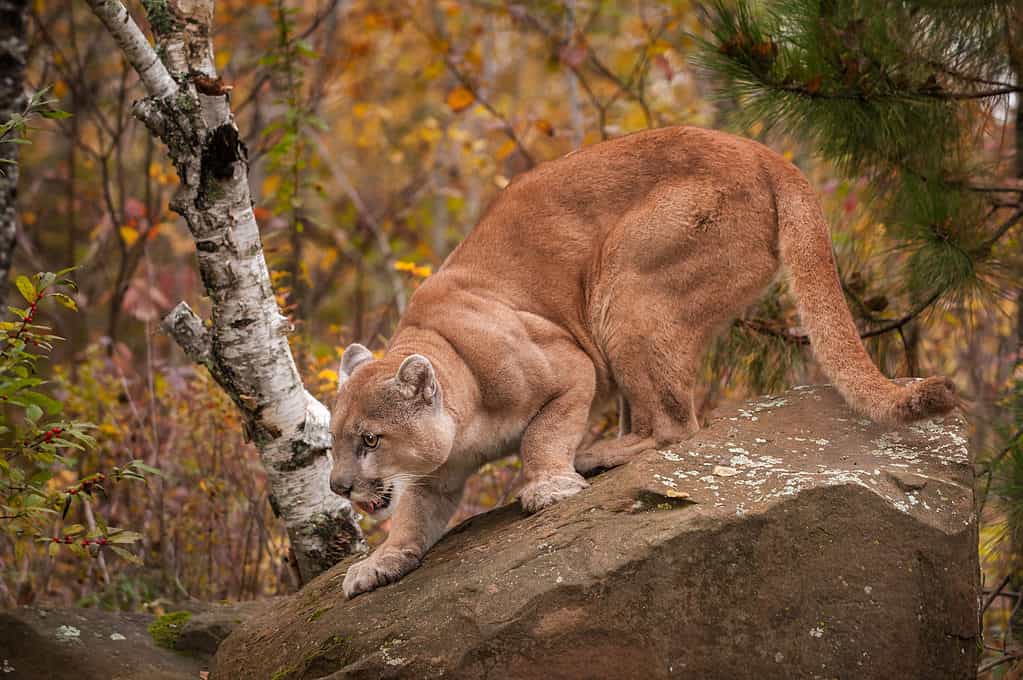
Mountain lions can leap 20 feet and run at 50 mph.
©Holly Kuchera/Shutterstock.com
9. Bighorn Sheep
In the summer months, bighorn sheep ascend Mount Elbert to graze on fresh grasses and alpine flowers, but in winter, they stick to the lower, lusher regions. Rocky Mountain bighorn sheep have thick winter coats that shed in summer to prevent overheating, and their cloven hooves allow a firm grip on mountainous terrain. They can climb almost vertical slopes to reach the choicest grasses and evade bear, wolf, or mountain lion predators. Their epic eyesight can spot predators a mile away!
How bighorn sheep got their name is no surprise. The biggest wild sheep in North America has two huge head horns formed from keratin and bone. Both rams and ewes produce horns, but males grow them larger. These incredibly heavy horns grow throughout the sheep’s life.
Males can weigh more than 300 pounds and stand over 3 feet tall at the shoulder, with females are typically around half the males’ size.
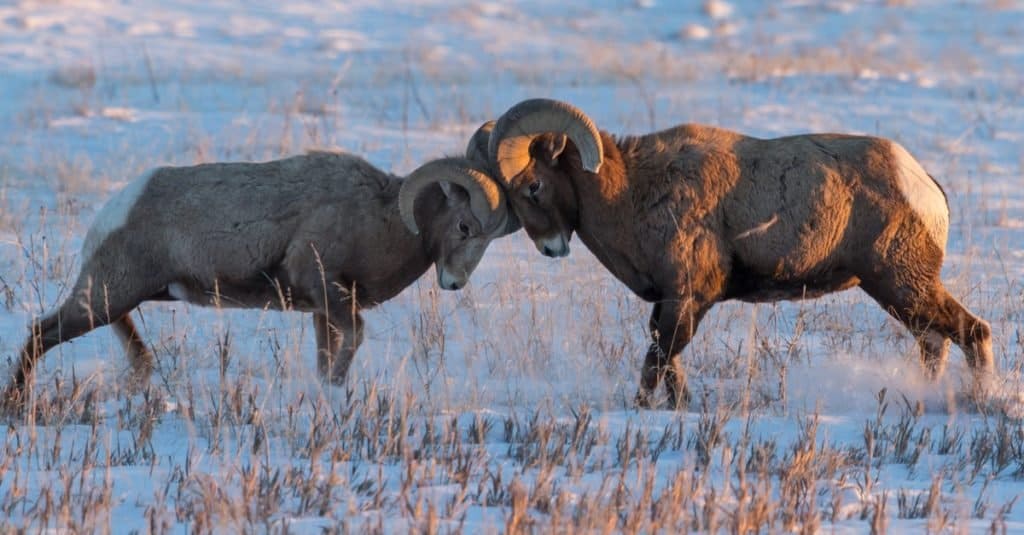
Keratin and bone form a bighorn sheep’s impressive curved horns.
©Warren Metcalf/Shutterstock.com
How to Spot Animals on Colorado’s Tallest Mountain
Mount Elbert is accessible to hardened hikers. Three main routes lead trekkers right to the peak, traversing forests, scree, slopes, and alpine tundra.
- North Elbert Trail: Starts north of Twin Lakes from the Colorado trail next to Elbert Creek Campground.
- South Elbert Trail: Easier than the north trail, but longer.
- Black Cloud Trail: The hardest, it’s a class 2 climb of steep elevation and unstable rocky places, and takes hikers through wilder spaces.
Even though Black Cloud trail is the most difficult, all three trails are wild, and hikers may encounter animals from the forest’s lower regions right through to the elevated alpine areas.
Keep your eyes peeled for cute pikas, noisy groundhogs, and an even closer eye out for rattlesnakes, mountain lions, black bears, and a rare wolf sighting.
Interesting Plants on Mount Elbert
Plant life on Colorado’s tallest mountain is varied and depends on the local ecosystem. In the lower forested elevations of Mount Elbert, aspen, spruce, pine, and fir trees thrive alongside lush grasses and wildflowers.
Further up in the sub-alpine region, can be found hardier grasses including long and flat-bladed carex, low-lying shrubs, and wildflowers such as the rare northern green orchid, purple sky pilot, white-bearded old-man-of-the mountains, and geums.
At the top, very little grows because it’s cold and windy. Trees are absent, but in summer, just down from the summit, trekkers might spot mountain avens, a mat-forming white and yellow flowering alpine in the rose family, and wind-pollinated Hendler’s meadow-rue.

Hardy, mat-forming mountain avens bloom during summer in Mount Elbert’s alpine region.
©iStock.com/Michel VIARD
Summary of 9 Animals That Roam Atop Colorado’s Tallest Mountain
Here’s a recap of the nine animal species that can be found on the slopes of Mount Elbert.
| Number | Animal | Mount Elbert Range | Size |
|---|---|---|---|
| 1 | Western Rattlesnakes | Below 8,000 feet | 4 feet long |
| 2 | Moose | Higher elevation areas | 5-7 feet tall and up to 1,600 pounds (males) |
| 3 | Wolves | It’s estimated 1,500 wolves inhabit the Rockies after reintroduction in 1990s. | 150 pounds (males) |
| 4 | Black Bears | Alpine zone and forested areas with chokeberries and serviceberries | Up to 594 pounds and reach 6.5 feet (males) |
| 5 | Marmots | Rocky subalpine Rocky Mountain habitats | 18.5-27.5 inches long |
| 6 | Mule Deer | Traverse most of Mount Elbert; tend to stick near forested areas; often seen by Black Cloud trail | Up to 460 pounds and 6.9 feet from nose to tail tip (males) |
| 7 | Pikas | Higher regions | 8 inches long |
| 8 | Mountain Lions | Most often seen in the forested montane regions; will ascend from subalpine to alpine regions when stalking prey | Can reach 5.5 feet long, with a 2-3 feet-long tail |
| 9 | Bighorn Sheep | Higher elevations in summer and lower, lusher regions in winter | Males weigh more than 300 pounds and stand over 3 feet tall at the shoulder; females are half the size |
The photo featured at the top of this post is © iStock.com/SeanXu
Thank you for reading! Have some feedback for us? Contact the AZ Animals editorial team.






